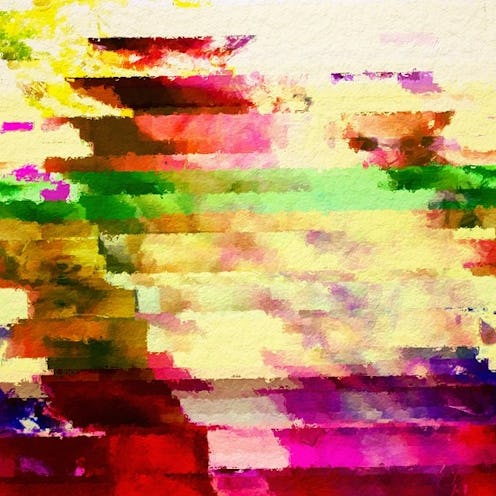
I don't believe absolute perfection exists — and moreover, I think there's a lot of beauty to be found in imperfection. This is probably why I dig the Twitter bot @PixelSorter so much: @PixelSorter makes images into glitch art, and all you have to do to make the magic happen is tweet at it. Created by front-end developer and Renassaince man Way Spurr-Chen (I'm not kidding, you guys — check out his website. He does it all, from programming to music), Pixel Sorter brings glitch art to the masses via some clever coding… and I definitely just lost a boatload of time to it. It's just that cool.
First things first: What the heck is glitch art? At it's simplest, it's pretty much what it sounds like — that is, art that harnessing the unique look of glitches caused by bugs in computer programs, images, videos, and other forms of digital information. As Wired noted in 2010, there's some debate over when the term “glitch art” actually applies; wrote Duncan Geere at the time, “Many argue that it can only apply when a glitch is unintentional — when it occurs naturally due to an error in hardware or software that leads to the corruption of whatever it is the artist was trying to create.” Using a technique called databending, though, glitches can be caused intentionally, making them a medium like any other — paint, clay, you name it. A glitch in its natural state may ostensibly be a “mistake,” but that doesn't stop it from looking absolutely gorgeous at the same time — which is exactly what glitch art gets at.
Spurr-Chen, who also curates the glitch art newsletter Glitchet, tells Bustle via email that he grew up around computers and spent a lot of his early childhood playing video games like StarCraft and modding the first Sims game. He later attended the Maryland Institute College of Art, where he majored in Video and Film Arts — during which time he also got really into Minecraft. “I wanted to run my own game server and make mods for it,” he says, “[but] I didn't know how to code or where to begin.” So, he hit the books: “I bought one of those six-inch thick reference manuals to teach myself Java. Eventually, I got into building websites to promote that server, and it eventually segued into a career doing web development.”
So why glitch art? “I honestly can't remember at this point [how I got into it],” Spurr-Chen says; he thinks it may have started with finding some glitches in the games he was playing and eventually stumbling upon the r/glitch_art subreddit (his favorite glitch artists include Creation by Destruction, aka Clif Pottberg; Collageno, aka Nicholas Kouri; James Usill; and Clara Luzian). Around that same time, he also discovered one of the first Twitter image bots, @badpng, which Spurr-Chen says “runs a faulty PNG compression algorithm against images and messes them up in an awesome way.” Inspired to create his own image bot, he reached out to @badpng's creators, who pointed him in the right direction; from there, he found a Ruby pixel sorting library available on Github “written by another developer who did all the hard work, really,” Spurr-Chen says. “I just wrapped it in a bot format.”
This, then, is what Pixel Sorter does: For every image it receives via at-mention on Twitter, it glitches it using one of a number of presets. As Spurr-Chen explains to me, the algorithm itself works by looking at a row or column of pixels; calculating a certain value for that row, with possible values including things like brightness or saturation; reordering the pixels in that row; and then repeating the process for every row. If you include “cmd[]” with your tweet with a set of parameters between brackets, you can even exert a little bit of control over the output Pixel Sorter will send back your way. The bot itself is designed to respond to people about four to five times per minute.
And it's super cool. It's how you can make an ancient photograph:
Into modern art I'd like to hang on my living room wall:
And how you can make an exact replica of a landscape:
Into an abstract interpretation of one:
And how you can make a cathedral:
Into the coolest television screen static you've ever seen:
And how you can make… well, this:
Into this:
Why, yes, that one is my favorite. Why do you ask?
Want to give it a shot yourself? Shoot @PixelSorter a tweet. Make sure you include both an image and an at-mention, and if you want to give those parameters a try, don't forget them, either. Androids might not dream of electric sheep, but they can certainly paint a mean piece of art.
Image: TORLEY/Flickr